Intel Broadwell Architecture Preview: A Glimpse into Core M
by Ryan Smith on August 11, 2014 12:01 PM ESTPutting It All Together: Low Power Core M
So far we’ve discussed Broadwell’s architecture on a broad basis, focusing on features and optimizations that are fundamental to the architecture. However to talk about the Broadwell architecture is not enough to fully explain the Core M itself. Though many of Core M’s improvements do come from Broadwell, Intel has also made a number of alterations to everything from the CPU packaging to the process node itself specifically for Core M. It’s the resulting combination of these factors that has allowed Intel to iterate on Broadwell-Y over Haswell-Y, and why Intel is so confident in Broadwell-Y’s capabilities and suitability for mobile form factors.
When it comes to building and configuring Core M, Intel likes to refer to their efforts as the “Fanless Challenge,” reflecting the fact that their biggest goal with Core M is to comfortably get the processor in to 10” tablets under 10mm in thickness that are passively cooled. A big part of getting into such a device is meeting the heat dissipation limitations of the form factor – a 10” tablet under 10mm would require a sub-5W SoC – which is where a lot of Intel’s engineering efforts have gone. Broadwell’s performance optimizations, the GPU optimizations, GPU duty cycling, and the 14nm process all contribute to getting a Core CPU’s power consumption down to that level.
But even that’s still not enough, and for Core M Intel went so far as to give Broadwell-Y its own die and design a low-power optimized version of their 14nm process just for it. This variant is designed to further reduce power consumption by optimizing the resulting transistors for lower power, lower voltage, lower clockspeed operation. By doing this Intel was able to further reduce power consumption in all of the major areas over what would be a traditional 14nm Intel process.
In the resulting 14nm Broadwell-Y process, voltage, capacitance, and leakage were all improved over the traditional 14nm process. Capacitance was reduced by 15%, minimum operating voltages by 10%, and leakage was improved to the point that it reduced SoC power consumption by 10%. The combination of all of these factors serves to significantly lower power consumption over what Intel’s traditional 14nm process would provide.
Working in concert with Broadwell-Y’s 14nm process, Intel has made a number of other changes to further reduce power consumption. Some of these are reflected in Broadwell’s overall design and others are unique to Broadwell-Y, such as using a lower TjMax for Broadwell-Y. By reducing the maximum operating temperature of the chip Intel has been able to realize further power savings by further reducing voltage and decreasing the maximum amount of temperature-dependent leakage the SoC will experience.
Meanwhile Broadwell-Y’s partner in crime, the on-package PCH, has received its own optimizations to reduce power consumption on the SoC’s total power consumption. The PCH itself is not much of a power hog in the first place – it’s still made on Intel’s 32nm process for this and cost reasons – but with such a strong focus on power consumption every watt ends up counting. As a result the Broadwell PCH-LP has seen optimizations that cut its idle power consumption by 25% and its active power consumption by 20%. Further improvements to the PCH’s monitoring hardware also mean it’s more responsive and can be controlled to a finer degree than the Haswell PCH-LP, and Intel has upgraded to a faster audio DSP to improve performance and reduce power consumption there as well.
Feeding all of that silicon in turn is Intel’s second generation Fully Integrated Voltage Regulator (FIVR), which further builds off of Intel’s other optimizations. The 2nd gen FIVR has been tuned for Broadwell-Y’s lower voltages, making the FIVR itself more efficient when delivering power at those voltages. To accomplish this Intel has implemented non-linear vDroop control, which is designed to better control the voltage when workload changes would cause voltage overshoots that waste power. And when even the 2nd gen FIVR isn’t efficient enough, this latest FIVR offers a second mode (LVR Mode) for low voltage/workload situations where the FIVR can be partially bypassed to reduce the FIVR’s power consumption.
Interestingly Broadwell-Y also sees the voltage regulation inductors redesigned and relocated in both the name of power efficiency and space efficiency. We’ll get to the case of space efficiency in a moment, but for power efficiency the new 3D inductors (3DLs) have been placed on the underside of the package, allowing the use of more efficient inductors that waste less power.
This brings us to the final element of Intel’s power optimization efforts, which involve further adjustments to turbo boost as part of Intel’s “hurry up and go to sleep” motto. New for Broadwell-Y is a 3rd power state, PL3, which allows for even greater turbo boosting, but for only a very limited period of time – on the order of milliseconds. PL3 represents the maximum amount of power the device battery can deliver, and while it’s okay to reach this value sparingly, PL3 is a fast drain that is very hard on the battery. The existence of PL3 in this case is as much for battery protection as it is for performance; it allows devices to tap into PL3 power levels on occasion, all the while allowing PL2 (the regular burst limit) to be defined at a safer value below the battery’s limit. Put another way, by knowing PL3 devices know how to stay farther away from it, which in the long run is what’s best for battery reliability.


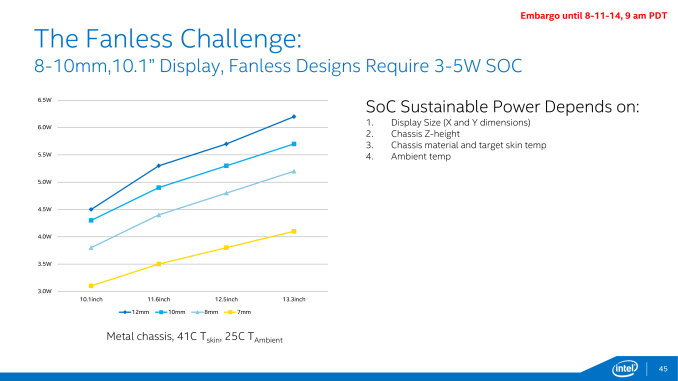
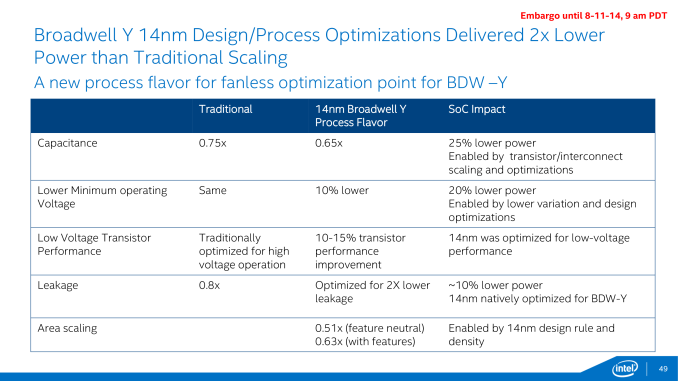
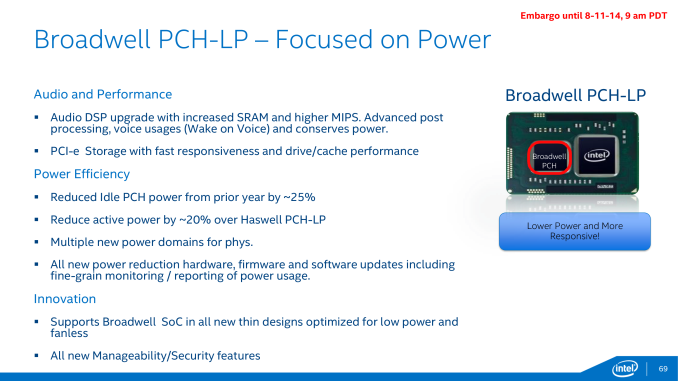
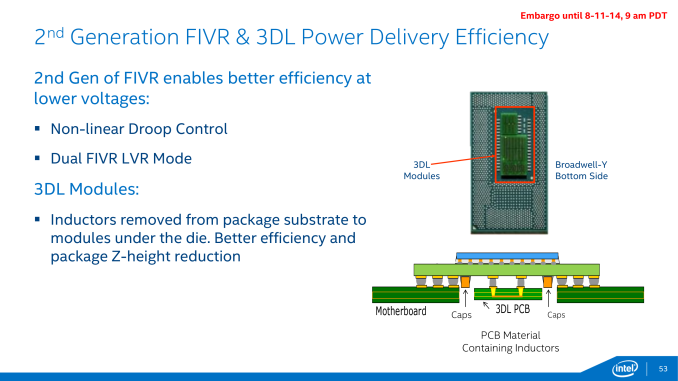

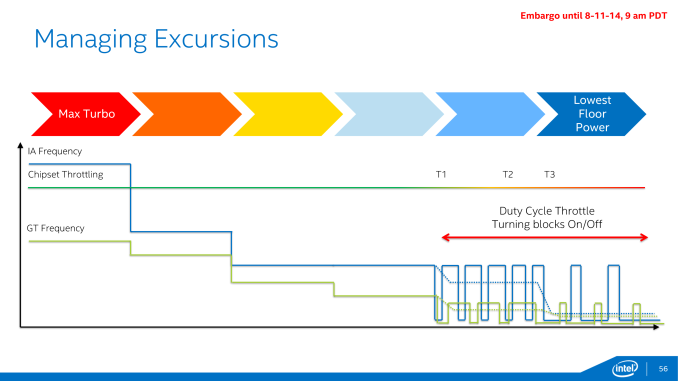








158 Comments
View All Comments
Jaybus - Thursday, August 14, 2014 - link
TDP is "Total Dissipated Power" and as used in describing processors refers to the maximum instantaneous power that the processor will dissipate. Watt, being a unit unit of power, is the only SI unit suitable for specifying TDP. Since nearly all of the energy expended by a processor is due to heat transfer, a Watt is in this case essentially a measure of the rate of heat transfer, and TDP is the rate of heat transfer required when operating the processor at or near its maximum operating temperature.473NG3R - Friday, August 15, 2014 - link
@Jaybus Nope. Please don't correct people with false info. TDP is Thermal Design Power, and it is NOT "peak" power. It is used for marketing as mkozakewich said above as the definition of TDP measurement varies from company to company.473NG3R - Friday, August 15, 2014 - link
Oops! I read mkozakewich comment backwards. It is a marketing term in a sense... It is used to design cooling systems but it gets thrown around by marketing groups all the time since TDP limits how small a device can be.frostyfiredude - Monday, August 11, 2014 - link
With all these reductions in power use on a per core basis and a stagnation of clock speeds we very well could see a quad core i7-5770k with a 65W TDP. I hope Intel plans on bumping up their mainstream high end SKUs to six core, the desktop market doesn't need maximum power use that low.klmccaughey - Monday, August 11, 2014 - link
Yes this worries me too. I think we will see yet another pointless desktop release, with hardly any improvements (once you consider the bad overclocking).I still don't see a desktop Broadwell replacing my 2500k, which runs low(ish) heat at 4.3GHz. What I would love to see is a 5.5GHz Broadwell monster, otherwise I will be skipping broadwell, just like Hazwell and IB before it.
Surely there has to be some light on the horizon for us gamers?!
mapesdhs - Monday, August 11, 2014 - link
And someone in your position also of course has the double irony of still having more
performance headroom if they're willing to explore better cooling, etc. H80i would let
your 2500K run at 5GHz no problem, assuming your particular sample isn't naturally
limited in some way (actually, even an old TRUE and two typical fans would be fine,
something I can confirm as I've done it with several different 2700Ks, never mind a
2500K, so I know the heat isn't an issue). Thus, except for threaded workloads, an
upgrade would have to be a lot better than what you already have in order to be
worth bothering with, except if you wanted something new due to newer tech sych
as PCI Express, M.2, etc.
Anyway, this is why IB was so bad with its default metal cap setup, ie. Intel made SB
too good which resulted in lots of 2500K owners just not seeing the point in upgrading.
Thing is, they've still not boosted performance enough to make upgrading worthwhile
for most SB users (the exception of course being non-K owners).
My 2700K runs at 5.0. Takes me 3 mins to set this up on an ASUS M4E, ludicrously
easy to do. HW at 4.5 is about the same or a bit quicker, but much more complex to
do, given how many samples won't go that high, and for gaming it makes no difference
at all. I suppose the 4790K can help on the oc front a bit, but the cost has put me off so
far, used 2700Ks are so much cheaper. I want to build a 4K gaming system next, but
that'll be X99 instead I think (don't see the point of mainstream chipsets for 4K gaming,
surely with multiple GPUs the limited PCIe lanes is going to hold back performance
eventually).
Ian.
garadante - Tuesday, August 12, 2014 - link
I wish I had your luck with SB. My 2500k will only do 4.5 GHz stable with 1.365 vcore (in reality, monitoring software reports 1.391~ vcore with my motherboard's way of handling vdroop). If I could go any higher, I'd have to dump a load of voltage into it that I'm just afraid of doing. Though this may be a motherboard problem as it's given me problems before, but that still wouldn't account for a 500 MHz variance. I guess I just got a bad SB. :/pt2501 - Monday, August 11, 2014 - link
You said it. My 2500k at 4.6 Ghz isn't going anywhere unless something revolutionary is released. Best processor I ever bought.ZeDestructor - Monday, August 11, 2014 - link
They want you to go up to LGA2011 for the solder-based TIM. And only because of die-cracking issues (I found the papers covering that) on smaller dies that force them to use boring old polymer TIM.steve wilson - Tuesday, August 12, 2014 - link
My thoughts exactly. My 2500k runs everything fine for me at 4.4ghz. I will be skipping Broadwell and praying Skylake will deliver.